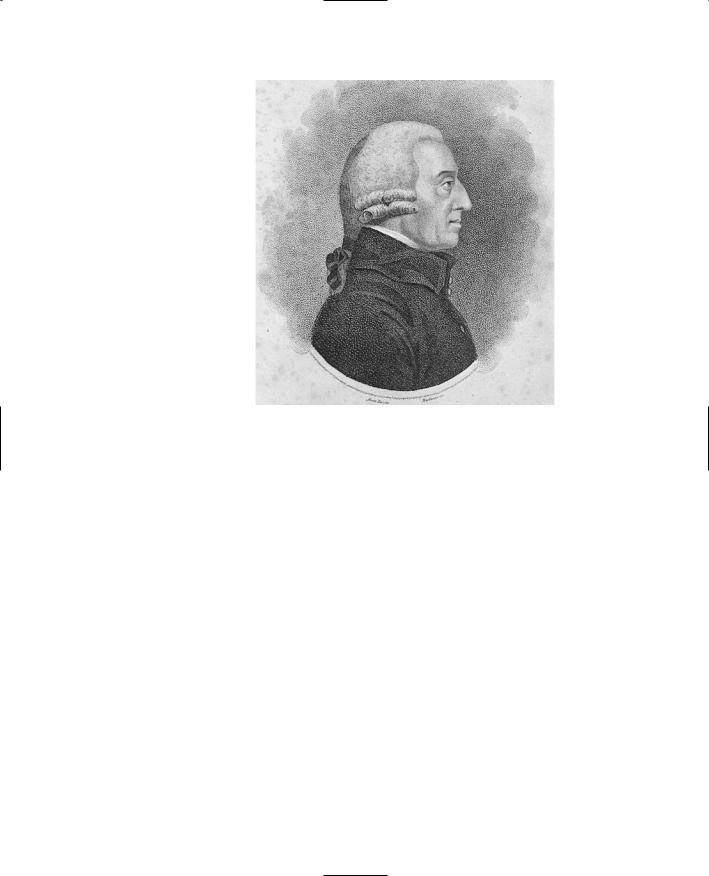
Liberalism
.pdf
CHAPTER 3 Liberalism |
55 |
to take England back into the Catholic camp—and to become, like his cousin Louis XIV of France, an absolute ruler. To prevent this occurrence, an effort was mounted to exclude James from the throne. During the Exclusion Crisis of 1680–1683, Charles II suspended Parliament and his opponents responded with plots and uprisings against him. The effort failed—James became King James II upon Charles’s death in 1685—but it did lead John Locke to begin writing his Two Treatises of Government.
Locke completed the Two Treatises while in exile in Holland, where he had fled for safety in 1683. In Holland, then the most tolerant country in Europe, Locke also wrote his Letter concerning Toleration. Both works were published in England after the Glorious Revolution of 1688 forced James II to flee to France. James’s daughter Mary and her husband William, Prince of Orange (in the Netherlands), became England’s new monarchs. In assuming the throne, however, William and Mary accepted the Bill of Rights, which recognized the “true, ancient, and indubitable rights of the people of this realm,”3 and the supremacy of Parliament. From this time forward England would be a constitutional monarchy, with the king or queen clearly subject to the law of the land. In the Toleration Act (1689), furthermore, Parliament granted freedom of worship to “dissenters,” that is, those Protestants who refused to join the established Church of England.
These developments were very much to Locke’s liking. In the Letter concerning Toleration he argued that it is wrong for governments to force their subjects to conform to a particular religion. Drawing a distinction between private and public matters, Locke said that religious belief is normally a private concern and not a proper subject for government interference. Governments should tolerate diverse religious beliefs unless the practice of those beliefs directly threatens the public order. But Catholicism should not be tolerated for exactly this reason. Catholics owe their first loyalty to a foreign monarch, the Pope, so they cannot be trustworthy members of a commonwealth. Locke also refused toleration to atheists for a similar reason, claiming that anyone who denied the existence of God, salvation, and damnation could not be trusted at all. If these seem severe restrictions by current standards, they were nonetheless quite liberal, even radical, by the standards of Locke’s time.
Important as his argument for toleration was, Locke’s theory of political authority in the second of his Two Treatises of Government (1690) marked an even more important milestone in the development of liberalism. Locke’s purpose in the Second Treatise was much the same as Hobbes’s in Leviathan—to establish the true basis for political authority or government—and in several crucial respects his premises resemble Hobbes’s. He began his argument, as Hobbes did, with the state of nature, where everyone is free and equal. There is no ascribed status in this state of nature, “there being nothing more evident, than that Creatures of the same species and rank promiscuously born to all the same advantages of Nature, and the use of the same faculties, should also be equal one amongst another without Subordination or Subjection. . . .”4 There are natural rights, though, which Locke usually referred to as “life, liberty, and property.” These rights a person may surrender or forfeit—by attacking others, for instance, a person may forfeit his right to life or liberty—but no one can simply take them away.
Unlike Hobbes’s state of nature, Locke’s is not a state of war. It is “inconvenient,” however, largely because so many people are unwilling to respect the rights of others. Recognizing this difficulty, people in the state of nature enter into a social contract

56 |
PART TWO The Development of Political Ideologies |
to establish a political society with laws and a government to make, interpret, and enforce them. But we should remember, Locke said, that people create government to do a job—to protect their natural rights. The government has authority, therefore, only insofar as it does what it needs to do to preserve the lives, liberty, and property of its subjects. If the government begins to violate these rights by depriving its subjects of life, liberty, and property, then the people have the right to overthrow the government and establish a new one in its place.
Although he began with premises very similar to Hobbes’s, Locke reached a very different conclusion. Both denied that social status was somehow fixed or ascribed by nature, and both believed that government is founded on the consent of the people; but Locke believed that people can consent to create and obey only a limited or constitutional government. To give anyone total and absolute power over people’s lives would be both irrational and contrary to the will of God. Both also believed that people have natural rights; but for Locke this included a right to worship as one chose, within limits, and a right of revolution—a right that would be invoked four score and six years after the publication of the Two Treatises of Government in the American Declaration of Independence.
The American Revolution
Neither the American Revolution nor the French Revolution was the direct result of Locke’s writings, of course. In both cases a variety of social, economic, and religious factors combined with philosophical and political issues to lead to revolution.
The thirteen British colonies that eventually became the United States were settled during the seventeenth century—a turbulent time for England. Perhaps because it was preoccupied with problems at home, the British government generally left the colonists to look after their own affairs during the 1600s. This situation continued throughout the first half of the eighteenth century, a relatively stable period in English politics. The colonies had governors appointed by the Crown, but they also had their own legislatures and raised their own taxes. The colonists consequently took it for granted that they enjoyed all the rights of Englishmen, including the right to constitutional self-government through elected representatives.
But in 1763, at the end of the French and Indian (or Seven Years) War, the British government began to levy taxes on the colonists in order to pay for the war and the defense of the colonies. The colonists objected that this violated their rights as Englishmen. Parliament had no right to tax the American colonists, they argued, as long as the colonists elected no representatives to Parliament. For Parliament to tax them when they had no voice in the matter was tantamount to taking their property without their consent. Indeed, the colonists’ position was quite simple: “No taxation without representation!”
Parliament’s response was to point out that the colonists were in exactly the same situation as most of the people of England itself, where only a small minority enjoyed the right to vote at that time. Because of corruption and outdated electoral rules, whole cities were without representatives; yet all British subjects were “virtually represented” by the members of Parliament, who looked after the interests of the entire commonwealth. To this argument the colonists replied by saying, in effect, that if the people of England were foolish enough to settle for “virtual” representation, so much

CHAPTER 3 Liberalism |
57 |
the worse for them. As the colonists saw it, if representation is not “actual,” it is not representation at all.
This, in brief, was the quarrel that led to armed revolt in 1775. In the beginning the colonists maintained that they were loyal subjects of the Crown who fought only to restore their rights—rights that the British government was supposed to protect but had instead violated. Yet in little more than a year the colonists abandoned this position to take the radical step of declaring themselves independent of Great Britain.
They took this step in part because of the arguments set out in Common Sense, a pamphlet written and published in February 1776 by Thomas Paine (1737–1809). The arguments of Common Sense are quite similar to Locke’s in the Second Treatise, but Paine expressed them in a vivid and memorable way. Society, Paine said, is always a blessing; but government, even the best government, is a “necessary evil.” It is evil because it coerces us and controls our lives; but it is necessary because most of us, fallen creatures that we are, cannot be trusted to respect the natural rights of others. To protect our natural rights, then, we create government. If the government does its job, it deserves our obedience. But if it fails to protect our natural rights—if it turns against us and violates our rights—the government ceases to be a necessary evil and becomes an intolerable one. When this happens, Paine concluded, the people have every right to overthrow their government and replace it with one that will respect their rights.
The American colonies, said Paine, should sever their ties with Great Britain and establish themselves as an independent, self-governing state. If it is to be truly selfgoverning, though, the new state must be a republic. Paine took this to mean that there must be no king, for he believed monarchy to be absolutely incompatible with individual liberty. In this respect he went beyond Locke—who may have preferred to abolish monarchy but did not say so in the Second Treatise.
Within six months of the publication of Common Sense, the Continental Congress declared, on July 2, 1776, that “These United Colonies are, and of right ought to be, free and independent states.” Two days later the Congress adopted the Declaration of Independence, a document written principally by Thomas Jefferson (1743–1826). The exact character of Jefferson’s justification of the separation from Great Britain is a matter of some dispute among scholars, but there is no doubt that the argument of the Declaration, as well as some of its striking phrases, closely resembles Locke’s.5 Thus, we are told that certain “truths” are “self-evident”:
that all men are created equal, that they are endowed by their Creator with certain unalienable Rights, that among these are Life, Liberty, and the pursuit of Happiness.—That to secure these rights, Governments are instituted among Men, deriving their just powers from the consent of the governed.—That whenever any Form of Government becomes destructive of these ends, it is the Right of the People to alter or to abolish it, and to institute new Government, laying its foundation on such principles, and organizing its powers in such form, as to them shall seem most likely to effect their Safety and Happiness.6
Following this preamble comes a long list of specific grievances submitted as evidence that the British government had indeed become “destructive of these ends” for which government is created, thereby entitling the colonists “to alter or to abolish it, and to institute new Government. . . .”

58 |
PART TWO The Development of Political Ideologies |
The Declaration of Independence, then, employs a compressed version of the argument advanced by Locke, Paine, and other early liberals. Two features of this argument deserve particular attention. The first is the claim that “all men are created equal. . . . ” This phrase caused some embarrassment when the Declaration was issued, for a number of colonists, American “patriots” as well as pro-British “tories,” pointed out that it was hypocritical for a slaveholding country to proclaim the equality of all mankind. In England Dr. Samuel Johnson criticized Washington, Jefferson, and other slaveholding colonists for their hypocrisy: “How is it that we hear the loudest yelps for liberty among the drivers of Negroes?”7 In fact, Jefferson, a slave-owner himself, included a sharp attack on the slave trade in his original draft of the Declaration. This section was removed by other members of Congress, however, while the claim that all men are created equal remained.
This embarrassment reveals a more general problem in the position of the early liberals. They spoke a democratic language when they proclaimed that all men are naturally free and equal and that government rests on the consent of the people; yet they never explained whom they counted as “men” or “the people.” For instance, Locke’s references to “men” and “the people” make him seem to be a democrat. But Locke did not clearly advocate an extension of voting rights beyond the property-holders who were allowed to vote in his day; he also held shares in a company engaged in the slave trade.8 Locke and other early liberals simply took it for granted, moreover, that natural equality and the right to self-government did not include women.9 By making these claims, however, early liberals provided an opening for those who could say, “If all men are created equal, why isn’t this or that group of men or women being treated as equals?” By speaking the language of equality, in other words, they contributed, perhaps unwittingly, to the growth of democracy and the expansion of the franchise.
A second feature of the Declaration that deserves particular attention is its defense of the rights and liberties of individuals against government. This defense is typical of early liberals, who saw government as a continuing threat to individual liberty; but it also shows the influence of classical republicanism, with its constant warnings about the danger of corruption. Indeed, the republican and liberal traditions were so closely entwined at this point that it is difficult to separate them. But there were differences of emphasis. Republicans worried about the corruption of the people as much as the corruption of the government, while early liberals were concerned almost exclusively with the abuse of power by government. Freedom, as republicans saw it, was largely a matter of governing oneself through political participation, and therefore closely connected with civic virtue; in the liberal view, freedom was more a matter of being free from interference by the government, and virtue something to be learned and practiced in private life.
Out of this combination came the Constitution of the United States. The Constitution provides for a strong central government, but it also limits the government’s powers in a number of ways. In this respect it is a republican as well as a liberal framework for government. But it also makes no direct provision for the promotion of civic virtue. Some of the Founding Fathers, including George Washington and James Madison, urged the creation of a national university partly for this purpose, but their efforts failed. In this respect, the lack of concern for civic virtue suggests the specifically liberal element of the Constitution—the attempt to prevent the government from

CHAPTER 3 Liberalism |
59 |
meddling in those areas of life, such as religion and the cultivation of character, that belong to the private domain.
Drafted in 1787 and ratified in 1788, the Constitution took effect in 1789. Two years later the Bill of Rights was added. These were momentous years for the United States, yet every bit as momentous elsewhere for the development of political ideologies. For in these years a revolution began in France that was to prove at least as important in world affairs as the events taking shape in the United States.
The French Revolution
To understand the French Revolution and liberalism’s role in it, we need to know something about the ancien régime—the “old order” of French society in the years before the Revolution. Three features of this old order are particularly important: its religious conformity, its aristocratic privilege, and its political absolutism. In all three respects, the condition of France before its revolution differed significantly from that of the American colonies before theirs.
First, religious conformity. In the years following the Reformation, France suffered a series of bloody civil wars between Huguenots (French Protestants) and Catholics. Most of the violence ended in 1598 with the Edict of Nantes, a compromise that granted freedom of worship to the Huguenots while acknowledging Catholicism as the official religion. This lasted until 1685, when Louis XIV, the so-called “Sun King,” revoked the edict and required all his subjects to conform to Catholic doctrine. From then until the eve of the Revolution, religious conformity remained government policy. This favored status, together with its wealth from its extensive landholdings, made the Catholic Church a bulwark of the ancien régime—and a major obstacle for those who desired a more open society. Chief among these were the thinkers of the Enlightenment, such as Voltaire (1694–1778), who believed that the light of reason would lead to a better understanding of the world and a freer, more rational society. For that to happen, however, reason would first have to overcome the forces of supersti- tion—forces led, as they saw it, by the Catholic Church.
Aristocratic privilege, the second leading feature of the old order, was a vestige of feudalism. In this respect France differed markedly from the American colonies, where hereditary aristocracy had never taken root. In France the roots of the aristocracy were very deep indeed, and most aristocrats were anxious to preserve the special rights they enjoyed as nobles. One of these privileges was exemption from most taxes. This exemption troubled the French government, which was constantly in need of funds, and was greatly resented by those who bore the burden of taxation—the middle class (bourgeoisie) and the peasants. Another important privilege the nobles enjoyed was the almost exclusive right to high positions in the government, military, and Church. Louis XVI, who was king when the Revolution began, chose almost all his advisers and administrators from the nobility and required all candidates for officer’s rank in the army to have at least four generations of noble blood.10 Aristocratic privilege meant, then, that in the ancien régime ascribed status counted far more than ability or effort—something else the bourgeoisie greatly resented.
Political absolutism, finally, placed the king above the law and concentrated political power in the throne. This was the legacy of Louis XIV, whose long reign

60 |
PART TWO The Development of Political Ideologies |
(1643–1715) set the pattern for absolute monarchy. According to tradition, the king of France was responsible to the Estates-General, which consisted of representatives of the three orders or “estates” of the country: the clergy, the nobility, and the bourgeoisie. But Louis XIV never convened the Estates-General—it had last met in 1614— and found ways of appeasing and weakening the three estates. He secured the Church’s support by suppressing the Huguenots; he drew the nobility to his extravagant court at Versailles, where they became dependent upon his favor; and he flattered the bourgeoisie by choosing some of his government ministers from their ranks. With no effective opposition to limit his power, Louis XIV was able to govern as he saw fit. As he supposedly said, “L’état, c’est moi” (“I am the state”).
Neither of his successors, Louis XV (r. 1715–1774) nor Louis XVI (r. 1774–1792), was as adept as the Sun King at exercising absolute authority, but both followed his example. Neither summoned the Estates-General, for instance, until a financial crisis finally forced Louis XVI to do so in 1788. This event sparked the Revolution.
When Louis XVI called for elections to the Estates-General in the winter of 1788–1789, he and the nobles expected the representatives of the First and Second Estates—the clergy and the nobility—to prevent any drastic action by the Third Estate, or “the people.” But the Third Estate insisted on double representation, and public pressure forced the king to concede. Then, with the support of some liberal nobles and parish priests, the deputies of the Third Estate declared themselves the National Assembly and began to draft a constitution for France. The French Revolution had begun.
Although the Revolution ended ten bloody years later with a new form of absolutism, the revolutionaries’ original aim was to establish a limited government that would protect the natural rights of French citizens—rights that the French kings had refused to acknowledge. The revolutionaries wanted to overthrow the old order, replacing religious conformity with tolerance, aristocratic privilege with equality of opportunity, and absolute monarchy with constitutional government. These aims are evident in their Declaration of the Rights of Man and of the Citizen of 1789. In the first of the Declaration’s seventeen articles, the National Assembly attacked aristocratic privilege and ascribed status: “Men are born, and always continue, free and equal in respect of their rights. Civil distinctions [i.e., ranks or estates], therefore, can be founded only on public utility.” The second and third articles attacked political absolutism, proclaiming that government rests on the consent of the governed:
II.The end [i.e., goal] of all political associations is the preservation of the natural and imprescriptible rights of man; and these rights are liberty, property, security, and resistance of oppression.
III.The nation is essentially the source of all sovereignty; nor can any individual, or any body of men, be entitled to any authority which is not expressly derived from it.
Nor did the National Assembly overlook religious conformity. In the tenth article of the Declaration it declared, “No man ought to be molested on account of his opinions, not even on account of his religious opinions, provided his avowal of them does not disturb the public order established by the law.”11 This and the other “rights of man,” it should be noted, were rights for males only. Females were not accorded

CHAPTER 3 Liberalism |
61 |
political and civil rights, as Olympe de Gouges pointed out with some bitterness in her “Declaration of the Rights of Woman and the Female Citizen” (1791).12
Liberalism was not the only current of thought in the French Revolution; republicanism, with its emphasis on civic virtue, also played a part. “Liberty, Equality, Fraternity”—the famous slogan of the Revolution—suggests how liberalism and republicanism were entwined, as they had been in the American Revolution. Every man has a right to be free, the argument went, because all are born equal, and each should have an equal opportunity to succeed. Yet liberty and equality were also prized, in republican terms, as the chief ingredients in an active public life directed toward virtue. The cry for “fraternity” also evoked republican themes, suggesting that the divisive civil distinctions be replaced with a sense of common citizenship. With this in mind, the revolutionaries abandoned the traditional titles or salutations of monsieur and madame and began to address everyone as citoyen or citoyenne (“citizen”). “Fraternity” suggested that there is more to life than being free to pursue one’s private interests; indeed, a citizen has a responsibility to participate actively in public life.13 “Fraternity” implied an interest in solidarity, in putting the common good ahead of one’s private desires. It also took on nationalistic overtones as the French thought of themselves less as subjects of a monarch than as citizens of a single nation.
As the Revolution continued, Church lands were “secularized” and sold, and, in 1791, the National Assembly drafted a constitution that limited the powers of the king, abolished the three estates, and granted the right to vote to more than half of the adult males. France thus became a constitutional monarchy, with a government more limited and a franchise more democratic than Great Britain’s.
Once begun, however, the Revolution could not be stopped. The more radical revolutionaries demanded greater democracy, help for the poor, and less concern for the protection of property. War broke out when Prussia and Austria sent armies to the French borders to check the spread of revolution and restore the ancien régime. One economic crisis followed another. Under the pressure of these circumstances, the revolutionaries abolished the monarchy and established the Republic of France on September 22, 1792; later revolutionaries proclaimed this the first day of the first month of the Year I, the beginning of a new era of history that required a new calendar. The events of the next year were no less dramatic. The execution of Louis XVI in January was followed by a new constitution granting universal manhood suffrage. Then, from June 1793 until July 1794, came the Reign of Terror. During this period the guillotine became the chief symbol of the Revolution. Some 300,000 people were arrested on suspicion of betraying the Republic, and more than 17,000 were executed in view of cheering crowds. The Terror ended when its principal leader, Maximilien Robespierre, was himself beheaded, and in 1795 a measure of calm was restored under another constitution. Less democratic than its predecessor, the Constitution of 1795 restricted the vote to the property-owning bourgeoisie and created a five-member Directory to head the government. This arrangement survived until 1799, when Napoleon Bonaparte seized power, turning France into a military dictatorship and later a monarchy with himself as emperor.
LIBERALISM AND CAPITALISM
In both the Old World and the New, then, liberalism was a vigorous revolutionary force. In the name of “natural rights” and “the rights of man,” liberals struggled for

62 |
PART TWO The Development of Political Ideologies |
individual liberty against the social, political, and religious arrangements that lingered from the Middle Ages. A central aspect of this struggle was the quest for economic liberty.
By opposing ascribed status, early liberals sought wider opportunities for more people, not just the privileged few born into the nobility. Economic opportunity was particularly important to the merchants, bankers, and lawyers who made up the middle class, or bourgeoisie. For them, acquiring wealth was the main avenue of social advancement. But in early modern Europe, this avenue was blocked by numerous churchand government-imposed restrictions on manufacturing and commerce. These restrictions included the traditional Christian limits on usury—the practice of charging interest on loans—and various local regulations concerning working conditions and the production, distribution, and sale of goods. In the seventeenth and eighteenth centuries, still other restrictions stemmed from the economic theory of mercantilism.
Mercantilism. According to mercantilist theory, one country could improve its economic strength only at the expense of others. Acting on this theory, European nationstates engaged in economic warfare that frequently led to real combat. One tactic was to establish colonies, extract their resources, and forbid the colonists to buy from or sell to anyone but the “mother country.” Another was to set high tariffs, or taxes on imported goods, to discourage the sale of foreign goods and encourage the growth of domestic industries. A third tactic involved monopoly, the practice of granting exclusive control over a market to a single firm on the grounds that this was the most efficient way to handle the risks of trade between the far-flung colonies and the European homeland. Two leading examples of monopolies were the Dutch East India and the British East India companies, each of which received from its own government (but not from the native peoples) the exclusive right to govern as well as to trade with vast colonial territories.
Mercantilism, then, attempted to promote the national interest directly through the use of restraints and monopolistic privileges. These attempts worked to the advantage of some—especially those who were able to secure the privileges—and to the disadvantage of others. The middle class, which generally fell into this second camp, pressed for a wider and more nearly equal opportunity to compete for profits. Anything less, they believed, was an unjust obstacle in the way of individual liberty. This liberal belief found expression in the economic theory of capitalism.
Capitalism. Under capitalism, economic exchanges are essentially a private matter between persons pursuing profits. This emphasis on private profit ran against the grain of much of the Christian and republican traditions, neither of which assigned great value to either privacy or profits. But the 1700s produced some forceful statements of the argument that people ought to be free to pursue their private interests, including their economic interests. One of the first was The Fable of the Bees, published in 1714 by Bernard Mandeville (1670–1733). Mandeville’s fable is the story of a hive in which the bees, shocked by their own selfishness, decide to reform and act with the good of others in mind. But reform proves disastrous. Soldier, servant, merchant, and most of the other bees are thrown out of work because there is no demand for their services. The richness and variety of life is gone. Indeed, Mandeville suggests, the hive

CHAPTER 3 Liberalism |
63 |
was much better off in the old, selfish days when the bees acted out of vanity and greed—a time when
. . . every Part was full of Vice, Yet the whole Mass a Paradise;
. . . .
Such were the Blessings of that state;
Their Crimes conspir’d to make them Great.
The moral of the story, captured in the subtitle of the Fable, is Private Vices, Publick Benefits.
This idea—that the best way to promote the good of society as a whole is to let people pursue their private interests—became the cornerstone of liberal economic thought in the eighteenth century. In the middle of the century a group of French thinkers, the Physiocrats, developed this idea into an economic theory. Arguing against mercantilism, the Physiocrats maintained that the true basis of wealth is neither trade nor manufactures but agriculture. Furthermore, they claimed, the best way to cultivate wealth is not through regulations and restrictions but through unrestrained or free enterprise. Their advice to governments—remove regulations and leave people alone to compete in the marketplace—was captured in the phrase, laissez faire, laissez passer (“let it be, leave it alone”).
The most thorough and influential defense of laissez faire was Adam Smith’s
Inquiry into the Nature and Causes of the Wealth of Nations (1776). Smith (1723–1790), a Scottish philosopher and economist, agreed with the Physiocrats’ attack on mercantilism and monopoly. Far from serving the public interest, Smith said, restraints on economic competition serve only the interests of those few people who are able to take advantage of them. For most people, lack of competition simply means higher prices and scarcer goods.
As a remedy, Smith recommended an economic policy that would allow individuals to compete freely in the marketplace. Not only is this the fairest policy, because it gives everyone an equal opportunity, but it will also be the most efficient. For there is nothing like self-interest—in this case, the desire for profits—to motivate people to provide the goods and services that others want. As Smith put it, “It is not from the benevolence of the butcher, the brewer, or the baker that we expect our dinner, but from their regard to their own interest. We address ourselves, not to their humanity but to their self-love, and never talk to them of our own necessities but of their advantage.”14 Smith reasoned that removing economic restrictions and privileges will encourage people to produce and sell goods for a profit. In order to turn a profit, producers have to produce either a better or a cheaper good than their competitors; otherwise, people will not buy their products. Private interest, set free, will thus indirectly promote the public good by making available more and better and cheaper goods. It is, Smith said, as if an “invisible hand” were directing all these self-interested competitors to serve the common interest of the whole society.
Smith also argued, against the mercantilists, for free trade between countries. If people in some foreign land can sell us something we want for less than it costs to produce it ourselves, then let them do it. High taxes on foreign imports may encourage industry at home, Smith said, but they do so at great cost to the consumer, who has fewer and more expensive goods available. In the long run, peaceful and unrestricted trade between countries benefits everyone.

64 |
PART TWO The Development of Political Ideologies |
Adam Smith (1723–1790)
From Smith’s point of view, then, government should have as little as possible to do with economic exchanges. Government has only three proper functions, he said. First, it must defend the country against invasion. Second, it must promote justice— mostly by protecting property rights—and maintain order. Finally, it must provide certain “public works” and institutions that private enterprise will not provide, such as roads, bridges, canals, and harbors (what economists now term the “infrastructure” necessary to the conduct of business), as well as public education. All other matters are best left to the private business of self-interested individuals, who should be free to make their way in the world as they see fit. In this respect, Smith and other advocates of capitalism have taken a liberal position.
LIBERALISM IN THE NINETEENTH CENTURY
In the early 1800s liberalism remained a revolutionary force. In South America liberal ideas helped to inspire struggles for independence in the Spanish colonies. Even in France, the dictatorship of Napoleon did not mean a return to the ancien régime. In his revision of the French laws, the Napoleonic Code, Napoleon gave lasting approval to the principle of civil equality: the aristocrats kept their titles but lost most of their economic and political privileges. While he reestablished Catholicism as the official religion of France, Napoleon also guaranteed freedom of worship to Protestants and Jews. Some Europeans even welcomed Napoleon’s conquests of their countries as liberation from the old aristocratic social order. Napoleon’s defeat of the Prussian army in 1806,
